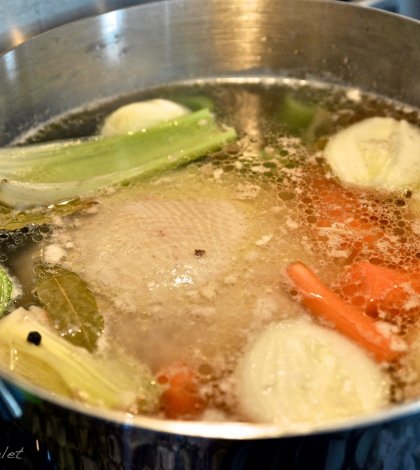God bless the French for introducing the world to fine cuisine! For if it weren’t the French, the world would have never known about the different gourmet sauces, the different cooking techniques and of course the huge variety of cheese (almost 400 of them)! Speaking of cooking techniques, some words have no equal equivalent in English and are thus addressed by their French name. Sauté and Braise are two such terms that I know off; I’m sure there must be more!
Coming back to our topic, the French have indeed mastered the art of making stocks. No true blue French cook would ever dream of using the canned or powdered variety of stock for his sauces. All their stocks are prepared in the kitchen using the freshest of ingredients. This perhaps explains the reason why a French chef carefully preserves the carcass of the every meat… from veal, beef, chicken, and even fish. Before you could even begin to understand about the different sauces, it’s important to get the different broths, including the chicken stock right.
The flavor for any stock comes from its bones, or rather the marrow in the bones. It is these bones that lend flavor to the stock and should be used as much as possible. It’s best if you could source your carcass from a local poultry seller who sells free-range birds. There are some who roast the bones and there are some who break the bones to allow the bone marrow to be absorbed well. Chicken feet and neck also make good ingredients for the stock. I know a lot many of you out there would squirm at the thought of using chicken feet. But chicken feet are filled with a lot of connective tissues that are made from collagen and small fragile bones with gelatin. These make the soup rich and give it a velvety texture.
Contrary to popular opinion, I suggest avoiding organs such as the gizzard, the liver, and the heart. The reason for not using these is the same as one for not using stock powder- they make the soup bitter.
And now, we come to the vegetables. The French commonly use carrot, leeks, onion (use the yellow variety if you want the stock to turn a deep yellow), and celery. Seasoning includes peppercorns, parsley, bay leaf, thyme, tarragon, oregano, basil, and garlic.
Adding salt can be tricky. This is because a stock usually takes hours to reduce. Once the liquid concentrates, salt can alter the taste considerably.
Once you’ve got the ingredients right for the chicken stock, be assured that you’ll get a great tasting sauce and soup.





















